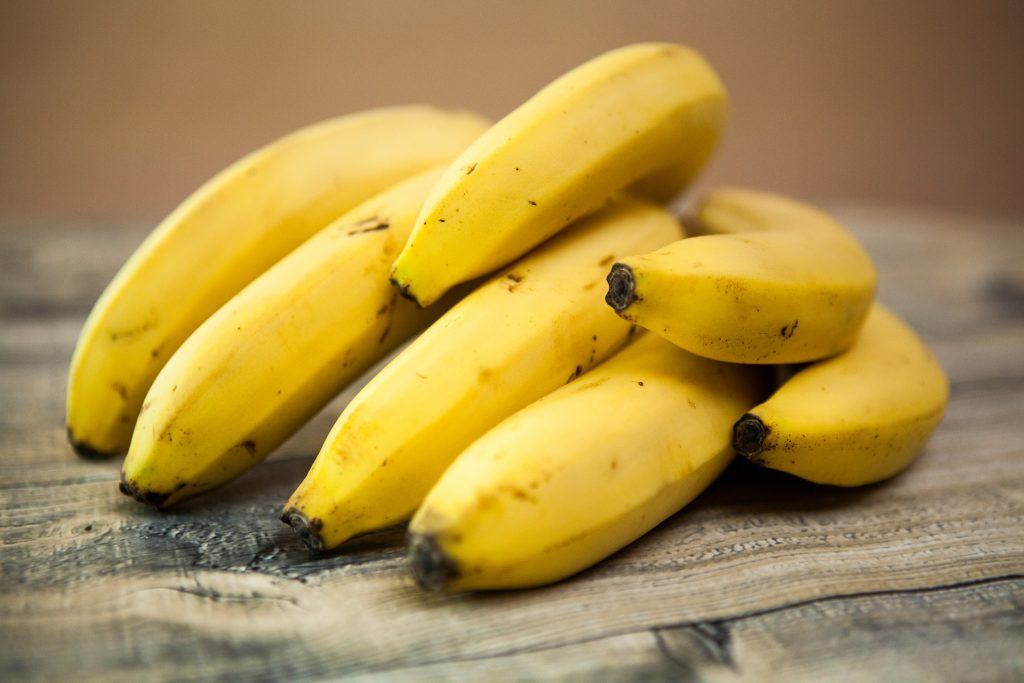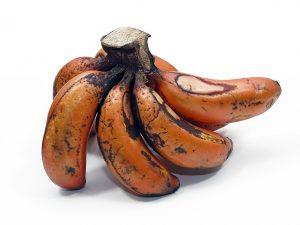
There’s a bit of confusion surrounding bananas. Some people consider this iconic golden fruit a healthy choice while others avoid it, after seeing it on Internet lists of “5 Worst Foods.” Unfavorable claims suggest that bananas cause weight gain and constipation. An article from 1917 published in the Journal of the American Medical Association defended the nutritional value of bananas, citing rumored beliefs during that time: “The banana is a cause of indigestion and a treacherous dietary component…” [1]
The scientific name for banana is Musa, from the Musaceae family of flowering tropical plants, which distinctively showcases the banana fruit clustered at the top of the plant. The mild-tasting and disease-resistant Cavendish type is the main variety sold in the U.S. and Europe. Despite some negative attention, bananas are nutritious and may even carry the title of the first “superfood,” endorsed by the American Medical Association in the early 20th century as a health food for children and a treatment for celiac disease.
Source Of
- Vitamin B6
- Fiber
- Potassium
- Magnesium
- Vitamin C
- Manganese
One serving, or one medium ripe banana, provides about 110 calories, 0 gram fat, 1 gram protein, 28 grams carbohydrate, 15 grams sugar (naturally occurring), 3 grams fiber, and 450 mg potassium.
Types
- Banana (Cavendish) – Sometimes classified as a “dessert banana,” this classic type is mildly sweet when ripe. Choose bananas with green or clear yellow peels without bruising. The ripening process will change the peel from being thick and stiff to thin and more flexible, with brown spots surfacing until the entire peel darkens. For best flavor, wait until the banana is golden yellow with a few brown spots. With continued ripening, the entire peel turns brownish-black and the pulp begins to ferment and soften further while losing sweetness.
The following are other banana varieties less commonly available in the U.S.
- Plantain (Green Banana) – Larger, starchier, and less-sweet version of Musa that is often used for cooking. When green, the plantain is unripe with a neutral flavor and firm flesh. In certain tropical regions including Central America, Africa, and the Philippines, the plantain is a major source of carbohydrate that is fried, boiled, or baked in a wide variety of dishes. If allowed to mature, the skin will yellow and develop a slightly sweet flavor that may be eaten raw or cooked.
 Red Banana – This variety is shorter and plumper than the Cavendish variety with a dark reddish-purple hue. A ripe red banana will be creamy and often sweeter than Cavendish bananas.
Red Banana – This variety is shorter and plumper than the Cavendish variety with a dark reddish-purple hue. A ripe red banana will be creamy and often sweeter than Cavendish bananas.- Lady Finger – Thinner and slightly shorter than the Cavendish bananas, they are sweeter and eaten raw or as dessert.
Bananas and Health
Do bananas have a high glycemic index?
According to the International Glycemic Index Database, ripe bananas have a low GI of 51, with slightly under-ripe bananas even lower at 42; they have a moderate GL of 13 and 11, respectively. Why is the glycemic load score higher if the glycemic index is low? It may be due to the higher carbohydrate content of bananas (there are 28 grams in one medium banana vs. about 19 grams in a medium apple); this will increase the glycemic load. However, the type of carbohydrate in bananas is classified as resistant starch, which functions similarly to dietary fiber. Resistant starch is not broken down in the small intestine so it causes less glucose to be released into the bloodstream. This produces a lower glycemic index and a greater feeling of satiety as the starch is digested slowly.
Storage
- Store at room temperature away from direct sunlight.
- Do not refrigerate green bananas as this can disrupt normal ripening.
- To speed up ripening, store in a brown paper bag or place near ripe fruit, which emits ethylene gas that causes ripening. On the flipside, if you wish to slow ripening, store bananas away from other ripe bananas or fruits. Do not store in plastic bags as this traps excess moisture and may promote rotting.
- Banana “trees” or hangers help expose a cluster of bananas to an even amount of oxygen, and promote gradual ripening by preventing excess pressure and moisture from collecting on the bananas at the bottom of the cluster.
- Fully ripe golden yellow bananas may be stored in the refrigerator in a sealed produce drawer. Refrigeration will preserve the flavor for another week, even if the peels continue to darken.
- If the banana peel has ripened to a mostly brown color, remove the peel and chop or mash the pulp to include in baked goods or freeze to be added into smoothies.
Prepare
 Slice ripe banana into a fruit salad. Squeeze a bit of acid like apple cider vinegar, orange juice, lime, or lemon onto the bananas to prevent darkening too quickly.
Slice ripe banana into a fruit salad. Squeeze a bit of acid like apple cider vinegar, orange juice, lime, or lemon onto the bananas to prevent darkening too quickly.- Substitute an equal amount of mashed banana for butter for dense baked goods like muffins, quick breads, and cookies. Using banana may cause the product to bake faster, so check for doneness several minutes earlier than usual or reduce the oven temperature by 25°F. The bananas will also add sweetness, so reduce the amount of added sugar in the recipe by one-quarter to one-half.
- For a frozen treat, slice a peeled ripe banana in half (in the middle) and insert a popsicle stick or skewer into the flat end. Dip banana into yogurt and coat evenly; sprinkle with nuts, chopped dried fruit, cinnamon, or other favorite toppings and freeze for several hours.
- For an easy dairy-free ice cream alternative, peel, chop, and freeze two medium bananas. Place into a blender or food processor and add a few tablespoons of liquid (water, dairy or plant milk, or coconut water). Blend until smooth. Add extra liquid if additional creaminess is desired. For a different flavor, add 1-2 tablespoons unsweetened cocoa powder or nut/seed butter, a splash of vanilla extract and cinnamon, or ½ cup frozen berries.
More recipe ideas and serving suggestions featuring bananas:
Did You Know?
- In many countries, banana and plantain leaves are recycled as food wrappers, such as to hold tamales and meats. They are also used to cover or wrap various foods while cooking to help seal in flavor.
- Banana peels contain plant chemicals in the form of antioxidants, and have long been used in traditional and folk medicine as an antiseptic and anti-inflammatory to promote wound healing such as for bug bites, minor burns, and sunburns. [4] As a simple home remedy, the inside of the banana peel is pressed on a wound for several minutes.

